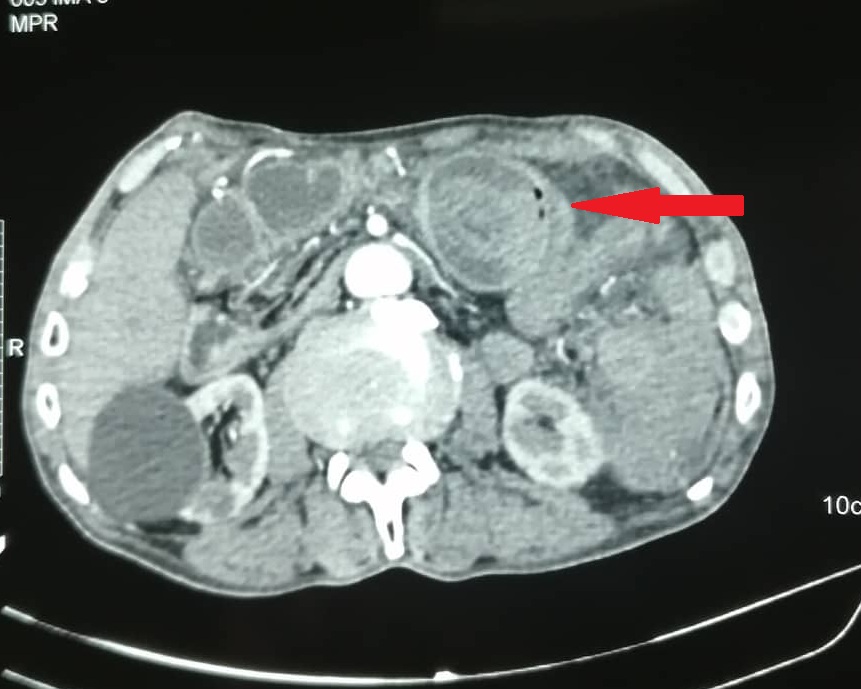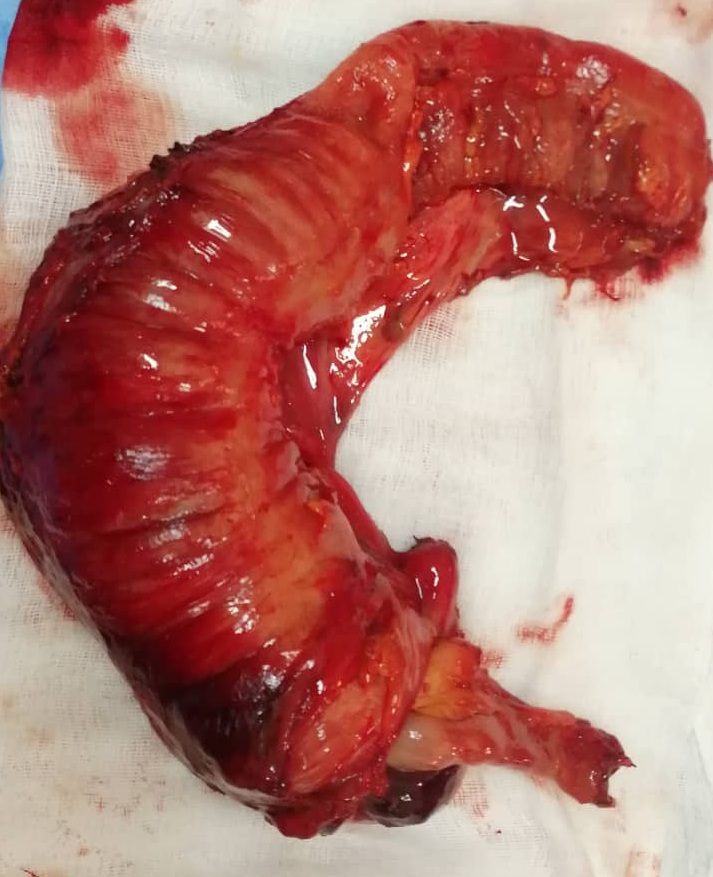Clinical Case Reports and Clinical Study
OPEN ACCESS | Volume 12 - Issue 5 - 2025
ISSN No: 2766-8614 | Journal DOI: 10.61148/2766-8614/JCCRCS
Ayadi MF1*, Dayem N2, Massoudi R1, BenBelaid A1, BenLahwel S1
1Department of General Surgery, Jendouba Hospital, Tunisia
2Department of ophthalmology, Charles -Nicolle Hospital, Tunisia
*Corresponding Author: Ayadi MF, Department of General Surgery, Jendouba Hospital, Tunisia
Received: September 17, 2022
Accepted: September 22, 2022
Published: September 26, 2022
Citation: Ayadi MF, Dayem N, Massoudi R, BenBelaid A, BenLahwel S (2022) “ A Rare Case of Bowel Intussusception Due to A Primary Colonic Mantle Cell Lymphoma within Adult.”, Clinical Case Reports and Clinical Study, 1(8); DOI: http;//doi.org/09.2022/1.150.
Copyright: © 2022 Ayadi MF. This is an open access article distributed under the Creative Commons Attribution License, which permits unrestricted use, distribution, and reproduction in any medium, provided the original work is properly Cited.
Intussusception is the telescoping of a proximal segment of bowel wall into the lumen of distal segment. While it is a common cause of bowel obstruction with in children it is rare with in adults with an estimated incidence of 2 cases/1,000,000 population/year and it is due to a malign neoplasm in 70% to 90% of the cases. Symptoms are variable and non specific with multiple presentations and CT imaging permit the diagnosis of most cases. The surgery is required in most of the cases and followed with chemotherapy depending on the histological type.
We report a case of colonic intussusceptions due to mantle cell lymphoma within an 83 years old patient the primitive colonic localization of this caner presents 1-4% of all digestive lymphoma. After surgery our patient is actually referred to a chemotherapy center.
Introduction:
Intussusception is the telescoping of a proximal segment of bowel wall into the lumen of distal segment [1]. It is a common cause of bowel obstruction with in children and is usally due to benign causes [2]. However it is rare with in adults with an estimated incidence of 2 cases/1,000,000 population/year [3], it is due to a malign neoplasm in 70% of the cases [1]. Symptoms are variable and non specific with multiple presentations and CT imaging permit the diagnosis of most cases [3]. While 80% of children’s intussusceptions can be treated medically, most of adults intussusceptions requires surgery [1,3].
We report a case of colonic intussusceptions due to mantle cell lymphoma within an 83 years old patient.
Case report:
An 83-year-old male patient with past surgical history of cholesetectomy 30 years ago, presented to the ophthalmology department for a cataract surgery. While examination, an epigastric mass off 10 cm was found. The patient was referred to our surgery department. The interrogation revealed that this mass appeared 4 days ago. It was painless and mobile. There were no other abnormalities. A CT scan was performed revealing a colonic intussusception du to an irregular wall thickening of the transverse colon suggesting of a malign tumor (figure n°1). No other abnormalities or secondary location were found. We decided to perform a med-line incision surgery due to the size of the mass and the past surgical history of the patient. Per operatively we find that the intussusception was taking the entire right colon (figure n°2). We performed a right oncological colectomy with ileo-colonic anastomosis.
Outcomes were simple and the patient was discharged the seventh day after surgery. The histological examination concluded to colonic a mantle cell lymphoma. And the patient is actually referred to a chemotherapy center.

Figure n°1: CT imaging showing the colonic intussusceptions(red arraow)

Figure n°2 : the intussuscepted colon after resection
Discussion:
Unlike for children, adult intussusception is a rare condition. Its incidence is estimated of 2 cases/1,000,000 population/year and equally affects both sexes [3]. This condition interests the small bowel in 52% of the cases, and large bowel in 38% the colon and in 10% of the cases it involves the stomach [3]. It is usually associated with a malign neoplasm in 70 to 90% of the cases [1,3]. Adénocarcinoma is responsible of 66 % of colonic intussusceptions [4]. Other etiology are reported like diverticulum, lymphoma, lipoma, strictures, polyps , secondary and inflammatory lesions [5].
For the mantle cell lymphoma, it represents 7% of adult non-Hodgkin’s lymphoma [6]. It is due to t(11:14) chromosomal translocation responsible of over expression of Cyclin D1 [7]. It involves the digestive tractus in 10 to 28% of the cases [6] however primary gastrointestinal location is accounting for only 1 to 4% of primary gastrointestinal lymphomas [6].
Within children the classical presentation includes abdominal pain, gelly stool and a sausage-shaped abdominal mass [3]. However for adult intussusceptions it is rarely encountered [5]. The presentation is off an acute bowel obstruction, which can be replaced by chronic signs particularly in case of colonic intussusception [1,5,7] making an accurate clinical diagnosis so difficult.
The “doughnut sign” and the “pseudo-kidney appearance” revealed by ultrasound imaging are rarely seen with in adult [8]. In some studies the CT-scan permitted the diagnosis in 100% of the cases [9]. It is the test of choice permitting the detection of lead points and the localization of the lesion [1]. The pathognomonic signs are a sausage shaped mass with a fat density ring contained within [10].
All thought some cases of successful laparoscopic or endoscopic reduction in some selected patient with an already known non malignant etiology were reported [11] the high rate of malignancy in adults with intussusceptions and due to the risk of perforation while pneumatic or hydrostatic reduction ,these procedures are not recommended [1,12].
The surgical en bloc oncologic resection is still recommended for adult colonic intussusceptions and the reduction of the intussuscepted bowel segment must be avoided due to the risk of tumor spillage [1].
The prognosis depends essentially on the etiology. In our cases it was a colonic mantel cell lymphoma, the Systemic chemotherapy for this kind of cancer usually consists of Cyclophosphamide, Adriamycin, Vincristine, and Prednisone plus Rituximab known also as R-CHOP protocol [13]. However it is known for poor survival and low response rate to systemic chemotherapy [14]. In fact the median survival is of 6 months [15].
Conclusion:
Adult intussusception is a rare condition and is due to a malign neoplasm most of the time. One of its etiologies is mantle cell lymphoma, although a rare entity, it should be invoked facing single colonic lesions. The surgical en bloc oncologic resection is recommended for adult colonic intussusceptions while the reduction of the intussuscepted bowel segment is prohibited due to the risk of tumor spillage.